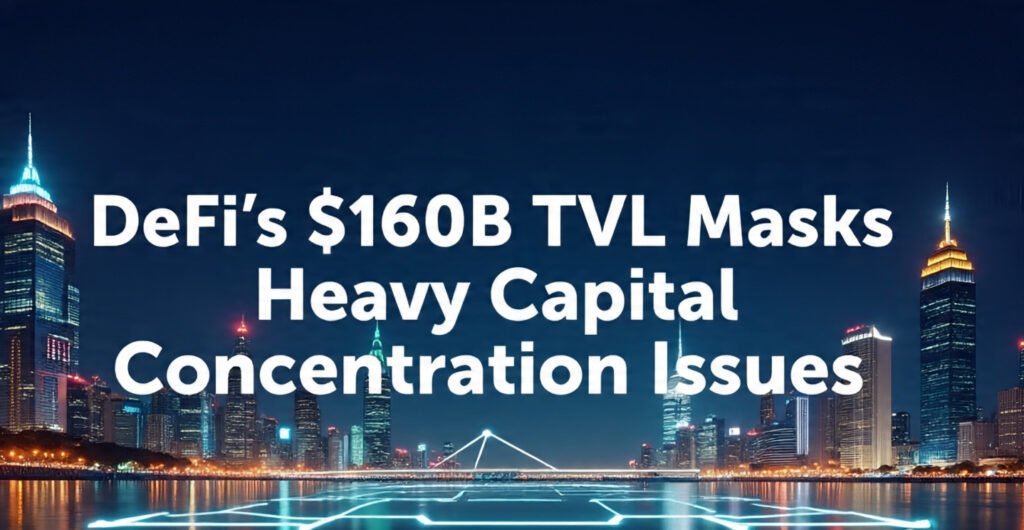The decentralized finance (DeFi’s) ecosystem has experienced remarkable growth, with total value locked (TVL) reaching an impressive $160 billion across various protocols and platforms. At first glance, this substantial figure suggests a thriving, diversified financial ecosystem where Capital flows freely among numerous innovative projects. However, beneath this seemingly vast landscape lies a more complex reality: the majority of DeFi’s Capital remains concentrated within a relatively small number of dominant protocols.
This Capital concentration phenomenon presents both opportunities and challenges for the broader DeFi ecosystem. While established protocols benefit from network effects and enhanced liquidity, the concentration raises questions about true decentralization, systemic risk, and barriers to entry for emerging projects. Understanding this distribution pattern is crucial for investors, developers, and regulators as they navigate the evolving landscape of decentralized finance.
The concentration of DeFi TVL in major protocols reflects natural Market Dynamics, where users tend to gravitate toward platforms offering superior security, yield opportunities, and an enhanced user experience. Yet this trend also highlights the gap between DeFi’s decentralized ideals and current market realities, where a handful of protocols command outsized influence over the entire ecosystem.
Understanding DeFi’s Total Value Locked (TVL) Landscape
Total Value Locked serves as the primary metric for measuring DeFi protocol adoption and success. This figure represents the total amount of cryptocurrency assets deposited across all smart contracts within a given protocol or the entire DeFi ecosystem. Currently, the $160 billion TVL distributed across hundreds of protocols creates an illusion of widespread Capital distribution.
The DeFi TVL calculation includes various asset types, from native cryptocurrencies like Bitcoin and Ethereum to stablecoins and protocol-specific tokens. This diverse asset base contributes to the impressive overall figure; however, the underlying distribution reveals a different story about Capital allocation patterns within the ecosystem.
Liquidity mining programs and yield farming opportunities have significantly influenced TVL growth, often creating temporary Capital flows that may not represent genuine long-term adoption. These incentive mechanisms, while boosting headline TVL numbers, can mask the actual underlying demand for DeFi’s services and contribute to the concentration effect as users chase the highest yields.
The Reality of Capital Concentration in Major Protocols
Despite the DeFi ecosystem’s apparent size, data reveals that approximately 70-80% of total DeFi TVL resides within the top 10-15 protocols. This Capital concentration becomes even more pronounced when examining specific categories, such as decentralized exchanges (DEXs), lending protocols, and liquid staking platforms.
Uniswap, Aave, MakerDAO, and Lido Finance consistently rank among the top protocols by TVL, each commanding billions in locked assets. These established platforms benefit from first-mover advantages, battle-tested smart contracts, and strong community trust – factors that naturally attract risk-averse Capitall in the volatile cryptocurrency market.
The concentration phenomenon extends beyond individual protocols to entire blockchain ecosystems. Ethereum-based DeFi protocols continue to dominate TVL rankings, despite the emergence of alternative layer-1 blockchains and layer-2 scaling solutions. This dominance reflects network effects, developer mindshare, and institutional comfort with the Ethereum ecosystem.
Network Effects and Liquidity Magnetism
Network effects play a crucial role in DeFi Capital concentration. Protocols with higher TVL often provide better liquidity, tighter spreads, and more efficient price discovery, creating a positive feedback loop that attracts additional Capital. This dynamic makes it increasingly difficult for newer or smaller protocols to compete effectively for market share.
Liquidity providers naturally gravitate toward protocols offering the best risk-adjusted returns, which typically correlate with established platforms having proven track records and substantial existing liquidity pools. This behavior reinforces the concentration trend and creates high barriers for protocol differentiation.
Top DeFi Protocols Dominating TVL Rankings
 Lending and Borrowing Giants
Lending and Borrowing Giants
Aave and Compound remain dominant forces in the DeFi lending space, collectively holding tens of billions in TVL. These protocols have established themselves as go-to platforms for cryptocurrency lending and borrowing, offering users the ability to earn passive income on their digital assets while providing collateralized loans.
MakerDAO, the pioneer of decentralized stablecoins, continues to maintain a massive TVL through its DAI stablecoin system. The protocol’s unique approach to collateral management and risk parameters has created a moat that newer competitors struggle to breach.
Decentralized Exchange Leaders
Uniswap stands as the undisputed leader in decentralized exchange TVL, with its automated market maker (AMM) model setting the standard for DeFi trading. The protocol’s simple yet effective design has attracted billions in liquidity and spawned numerous competitors attempting to capture market share.
Curve Finance has carved out a dominant position in stablecoin trading and yield optimization, becoming the preferred platform for large-volume, low-slippage trades between similar assets. Its specialized focus has allowed it to maintain a significant TVL despite intense competition.
Liquid Staking Dominance
Lido Finance has emerged as the clear winner in liquid staking, controlling a substantial portion of staked Ethereum through its stETH token. This dominance raises concerns about validator centralization and the concentration of staking rewards within a single protocol.
Factors Driving Capital Concentration
Security and Trust Considerations
Smart contract security remains paramount in DeFi protocol selection, with users preferring battle-tested platforms that have undergone extensive security audits and demonstrated resilience against exploit attempts. This preference naturally favors established protocols with long operational histories.
Insurance coverage and risk mitigation tools are more readily available for major protocols, providing additional security layers that attract institutional and risk-conscious retail Capital. Smaller protocols often lack these protective measures, limiting their appeal to conservative investors.
Yield Optimization and Capital Efficiency
Yield farming strategies and liquidity mining rewards have a significant influence on capital allocation decisions. Major protocols can afford to offer competitive incentives through token emissions and fee sharing, making them more attractive to yield-seeking investors.
Capital efficiency improvements, such as concentrated liquidity features and multi-asset yield optimization, are more commonly found in well-funded, established protocols with dedicated development teams.
Regulatory Clarity and Compliance
As DeFi regulation evolves, major protocols are better positioned to navigate compliance requirements and adapt to changing regulatory landscapes. This advantage becomes increasingly crucial as institutional adoption accelerates and regulatory clarity improves.
Implications for DeFi Innovation and Competition
The Capital concentration trend has significant implications for DeFi innovation and the long-term health of the ecosystem. While concentration enables efficiency and liquidity depth, it may stifle innovation by making it difficult for new protocols to gain traction and secure necessary funding.
Emerging DeFi protocols face substantial challenges in attracting TVL without offering unsustainable yield incentives or taking excessive risks to differentiate themselves. This dynamic can lead to a race to the bottom in risk management or unsustainable tokenomics models.
Innovation Bottlenecks
DeFi development may become increasingly concentrated among well-funded teams working on established protocols, potentially slowing the pace of fundamental innovation. Smaller teams may struggle to compete for developer talent and user attention in an increasingly crowded marketplace.
Cross-protocol composability benefits from having dominant protocols serve as infrastructure layers, but this arrangement can also create single points of failure and reduce system resilience.
Challenges and Risks of Concentrated TVL
Systemic Risk Concerns
The concentration of DeFi Capital in a handful of protocols creates potential systemic risks that could cascade throughout the entire ecosystem. A significant exploit or smart contract vulnerability in a primary protocol could trigger widespread liquidations and market contagion.
Counterparty risk becomes more pronounced when large portions of the DeFi ecosystem depend on the continued operation and security of a few dominant protocols. This concentration contradicts the decentralized ethos that originally motivated DeFi development.
Market Manipulation Vulnerabilities
Large TVL concentrations can create opportunities for market manipulation, particularly in governance token voting and protocol parameter changes. Dominant token holders may exercise outsized influence over protocol governance, potentially prioritizing their interests over broader ecosystem health.
Liquidity fragmentation across multiple protocols may actually provide more robust price discovery and reduce manipulation risks compared to highly concentrated liquidity pools.
Future Outlook: Potential for Capital Distribution
Emerging Layer-2 Solutions
 Layer-2 scaling solutions and alternative blockchains offer opportunities for Capital distribution by providing lower transaction costs and enhanced user experiences. These platforms may attract TVL away from Ethereum mainnet protocols, promoting greater decentralization.
Layer-2 scaling solutions and alternative blockchains offer opportunities for Capital distribution by providing lower transaction costs and enhanced user experiences. These platforms may attract TVL away from Ethereum mainnet protocols, promoting greater decentralization.
Cross-chain bridges and multichain protocols are gradually enabling more fluid Capital movement between different blockchain ecosystems, potentially reducing the concentration effect over time.
Regulatory Impact on Distribution
Evolving DeFi regulations may force Capital redistribution as compliance requirements favor different protocol structures and operational models. Regulatory clarity could also level the playing field for smaller protocols by reducing uncertainty and enabling institutional participation.
Geographic regulatory differences may drive Capital flows toward protocols and jurisdictions offering more favorable regulatory environments, promoting natural diversification.
Conclusion
While DeFi’s impressive $160 billion TVL suggests a mature and diversified ecosystem, the reality reveals significant Capital concentration within a small number of dominant protocols. This concentration reflects natural market dynamics driven by security concerns, network effects, and yield optimization, but it also presents challenges for true decentralization and innovation.
The DeFi landscape continues evolving as new scaling solutions, regulatory frameworks, and innovative protocols emerge. Whether this evolution leads to greater Capital distribution or further concentration will depend on how successfully the ecosystem balances efficiency with decentralization principles.
Understanding these concentration dynamics is crucial for all DeFi participants, from individual yield farmers to institutional investors and protocol developers. As the space matures, finding the right balance between Capital efficiency and decentralized principles will determine DeFi’s long-term success and resilience.

